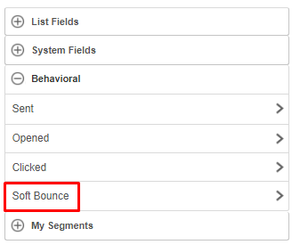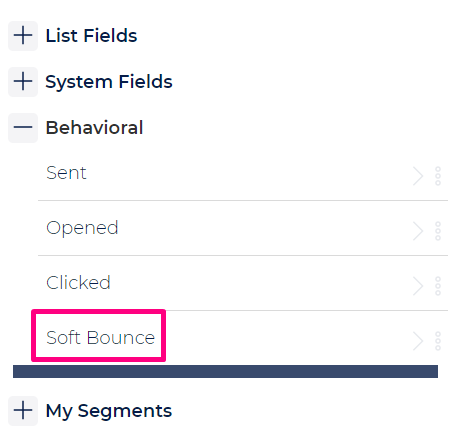Table of Contents:
Table of Contents minLevel 2
Basic Delivery and Performance Terms Explained
![]() The following is a list of delivery KPIs you'll find in all the various Ongage analytic reports.
The following is a list of delivery KPIs you'll find in all the various Ongage analytic reports.
...
- The soft bounce value is the number of soft bounces that occured in a given campaign or time-frame. The accompanying rate value is based on 'Soft Bounce' / 'Sent'.
- A soft bounce is a temporary status. It means the receiving server (e.g., Gmail, Yahoo, etc.) rejected the email message, even though the email address does exist on that server. So as long that email address is a soft bounce and not a hard bounce, one can continue to attempt to send to it.
 Note: Soft bounces are addressable email addresses that may soft bounce having nothing to do with the specific email address itself, but rather due to IP and/or domain reputation. In the event where the email address fell out of use, that address will eventually hard-bounce, either by the SMTP vendor or the mailbox provider.
Note: Soft bounces are addressable email addresses that may soft bounce having nothing to do with the specific email address itself, but rather due to IP and/or domain reputation. In the event where the email address fell out of use, that address will eventually hard-bounce, either by the SMTP vendor or the mailbox provider.
- Therefore, in Ongage soft bounced emails are active emails (unlike hard bounced, unsubscribed, and complaints, which are in-active and automatically deactivated and are never sent to).
- Ongage does not have any policy to change soft bounces to hard bounces and leaves that logic up to the outbound ESP/SMTP. I.e., Ongage does not change soft bounces to hard bounces on it's own.
- Ongage does provide a behavioral segment field called 'Soft Bounce', that marketers can use to exclude SBs from their regular sends, in order to "cool down" for X amount of time (typically 3 - 7 days).
 For more about how to setup a soft bounce cool down segment see our Segments help page and see there: 'How to Cool Down and Automatically Exclude Soft Bounces'.
For more about how to setup a soft bounce cool down segment see our Segments help page and see there: 'How to Cool Down and Automatically Exclude Soft Bounces'. - High soft bounce rates (typically greater than 5%, though one should strive for much less e.g. below 1%-2%), are a sign of an issue with your sender reputation (either IP or sending domain). It is recommended to do a Mail-Tester test to see if your sending domain is fully authenticated. Mail-Tester will also uncover other factors that may be impacting on your reputation. Adding throttling to your campaign can help in some cases. In more severe cases, you'll need to rebuild your reputation with a re-warm-up of your sending domain and/or IP, using your most engaged contacts.
...
- These are emails addresses that Ongage sent over to the SMTP vendor in order to be sent-out, but ended up not getting sent by the SMTP vendor. So they are neither Sent nor Bounced (and neither hard bounced nor soft bounced). This is by and large a rare scenario and does not happen on all SMTP vendors. Moreover this only occurs if and when the sender has a reputation issue with one or more Mailbox services (aka ISPs), they are sending to e.g., Gmail, Yahoo, Oulook, etc. This is what happens: let's say the sender has a reputation issue with Outlook.com. Due to that Outlook.com will only accept a certain amount/rate of emails per hour from that sender. If the campaign is large, in the end not all email addresses will end up getting sent. Those that don't get sent, become deferred / expired. Currently in Ongage there is no special designated status for deferred / expired, as there is for hard bounces and soft bounces. Since they were never sent, you'll see a notably lower sent count than targeted when this occurs. That along with often a high soft-bounce rate, is usually a strong indicator for this issue. Sending a Mail-Tester can often further confirm a related reputation issue.
Delivery Terms FAQ
![]() FAQs about some of these terms and how they work in Ongage.
FAQs about some of these terms and how they work in Ongage.
...
How does Ongage count opens
- Ongage automatically places a 1x1 transparent image pixel into the bottom of each email message. When that image is downloaded it is tracked via Ongage's tracking server. This 1x1 transparent image pixel is placed right before the closing </body> tag, i.e., at the bottom of the HTML email message.
- Note: When exporting Openers for campaign X, that number should match the number of unique opens (as the raw open count will be bigger, as the raw count includes recipients that opened an email more than once).
Opens in Ongage are implied
...
For how long does Ongage collect Open and Click Stats for a given campaign
- Ongage collects Opens/Clicks for all campaigns that were sent up to 45 days ago.
- Meaning if you open/click an email message, that was sent more than 45 days ago, those stats will not be counted, and the behavioral will also not be registered.
Are the 'Unsubscribe' and 'View Email in Browser' links counted
...
How long do we maintain the 'View in Browser' link
- 90 days
Addendum
Gmail Discrepancy in Open Rates
...
| Info |
|---|
Gmail offers a feedback loop (FBL) to high volume senders and email service providers (ESPs). The Gmail FBL is not like those offered by other mailbox providers, because it does not send complaints in the Abuse Reporting Format (ARF). Gmail's FBL only provides a report with aggregated spam statistics for @gmail.com recipients based on specific identifiers in the header, in order to protect their users' privacy. It is important to note that some lower volume senders may not see feedback loop data, even if all requirements for implementing the feedback loop are met. Gmail requires senders to hit an undisclosed volume and spam complaint threshold for data to be available. So, large volume senders and ESPs typically benefit the most from Gmail's feedback loop data. |
To implement the feedback loop, Gmail requires that you insert a special header called the Feedback-ID. And the header is required in either of the following formats:
...
- “a:b:c” are the optional 3 fields which can be anything you choose (campaign/customer/other)
- “SenderId/ESPid” is the only required field. This ID corresponds to an Sender/ESP customer and must be unique and persistent to that customer.
For the optional 3 fields, in Ongage you can inject following values:
- Literal value e.g., 10, IP-Pool, etc.
- Ongage System Field For example {{ocx_mailing_id}}, {{ocx_child_id}}, {{ocx_esp_id}} etc.
- Ongage Dynamic List Field For example {{unique_id}} where "unique_id" is the custom data field added in your Ongage List.
...

